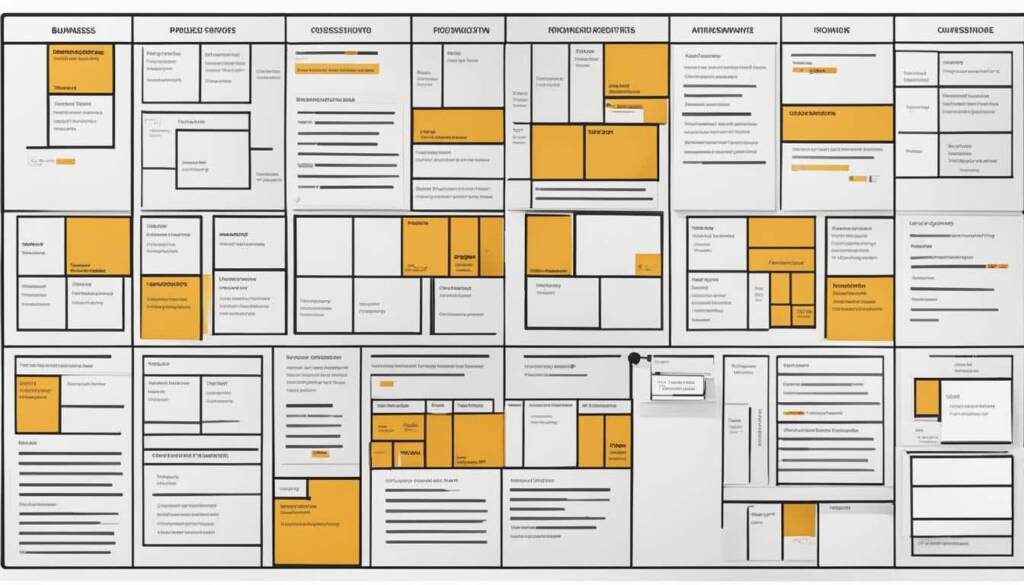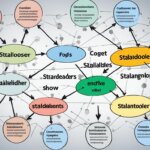Table of Contents
The Business Model Canvas (BMC) is a valuable tool for strategic start-up and business planning. Created by Swiss entrepreneur and Strategyzer co-founder, Alexander Osterwalder, the BMC provides a visual representation of the 9 key building blocks that form the foundations of every successful business. These building blocks include Customer Segments, Value Propositions, Channels, Customer Relationships, Revenue Streams, Key Resources, Key Activities, Key Partners, and Cost Structure.
The BMC is highly regarded within the business community for its simplicity and ability to provide a high-level analysis of a business model. It allows entrepreneurs, business owners, and strategists to analyze, structure, and evolve a business while keeping the bigger picture in mind. By utilizing the BMC, businesses can effectively identify opportunities for growth and make informed decisions based on a comprehensive understanding of their business model.
Overcoming Biases in Business Model Canvas: Pre-Workshop Strategies
One important aspect of using the Business Model Canvas (BMC) is overcoming biases in its application. Biases such as confirmation bias, availability bias, anchoring bias, and overconfidence bias can impact the objective analysis of business models within the BMC.
“Biases are like glasses we wear that distort our vision of reality, affecting our decision-making process. Recognizing and addressing biases is crucial for a comprehensive and unbiased analysis of business models within the BMC.”
To overcome these biases, pre-workshop strategies can be implemented:
-
Actively challenge assumptions: Encourage participants to question and critically evaluate assumptions underlying the business model. By challenging assumptions, it becomes easier to identify potential biases and explore alternative perspectives.
-
Seek contradictory evidence: Encourage participants to search for evidence that contradicts their initial assumptions or beliefs. This helps in uncovering hidden biases and broadening the understanding of the business model.
-
Broaden information sources: Encourage participants to consider a diverse range of information sources, including different industries, market trends, and customer insights. This helps in gaining a more comprehensive view of the business model.
-
Encourage diverse perspectives: Facilitate an inclusive environment where participants with diverse backgrounds and experiences can contribute their perspectives. This promotes open-mindedness and helps in overcoming biases rooted in limited viewpoints.
-
Promote open-mindedness: Emphasize the importance of keeping an open mind during the analysis process. Encourage participants to challenge their preconceived notions and be receptive to new ideas and insights.
-
Encourage creative thinking: Foster an atmosphere of creativity and innovation during the workshop. This encourages participants to think beyond conventional norms and explore unique solutions to business challenges.
-
Question established norms: Encourage participants to question established norms and industry practices. This helps in challenging biases that may be deeply rooted in traditional approaches.
-
Remain open to adaptation: Recognize the importance of adaptability in the face of changing market dynamics. Encourage participants to be open to adapting and evolving the business model based on new insights and feedback.
-
Foster a culture of humility and critical thinking: Create an environment where participants feel comfortable admitting mistakes and asking critical questions. This promotes a culture of humility and continuous improvement.
-
Embrace constructive feedback: Encourage participants to provide constructive feedback to each other during the workshop. This facilitates the identification and correction of biases through collaborative learning.
-
Conduct rigorous testing: Test the assumptions and hypotheses underlying the business model through real-world experiments and data analysis. This helps in validating or disproving biases and refining the model.
-
Engage in continuous learning: Encourage participants to embrace a mindset of continuous learning and improvement. This ensures that biases are addressed throughout the lifecycle of the business model.
Implementing these pre-workshop strategies can help in overcoming biases and promoting a more objective and comprehensive analysis of business models using the Business Model Canvas.
The Impact of Biases on Business Model Canvas Analysis
Biases in the analysis of business models using the BMC can heavily influence decision-making and hinder the identification of potential flaws or areas for improvement. These biases can result in a skewed understanding of customer needs, an overestimation of market demand, or a failure to recognize competitive threats. Overcoming biases is critical for accurate analysis and effective decision-making.
| Common Biases | Impact on BMC Analysis |
|---|---|
| Confirmation Bias | Leads to selectively interpreting and favoring information that confirms pre-existing beliefs, potentially overlooking contradictory evidence. |
| Availability Bias | Causes overreliance on readily available information, overlooking less accessible but potentially crucial data. |
| Anchoring Bias | Influences analysis by fixating on initial information or reference points, limiting exploration of alternative possibilities. |
| Overconfidence Bias | Leads to overestimation of abilities and underestimation of risks, resulting in unwarranted confidence in the business model. |
Understanding the Components of the Business Model Canvas
The Business Model Canvas (BMC) is a powerful tool that consists of 9 key building blocks essential for understanding and analyzing a business model. Each component plays a crucial role in shaping the overall structure and success of the business.
1. Customer Segments
The customer segments refer to the distinct groups of individuals or organizations that a business aims to serve. Identifying the target audience helps businesses tailor their products or services to meet specific needs and preferences.
2. Value Propositions
The value propositions define the unique value that a business offers to its customer segments. It highlights the benefits, advantages, and solutions that distinguish the business from its competitors.
3. Channels
The channels encompass the various means through which a business reaches its customer segments and delivers its value propositions. This includes both physical and digital channels, such as physical stores, online platforms, and social media.
4. Customer Relationships
The customer relationships focus on how a business acquires, retains, and grows relationships with its customer segments. This involves understanding customer preferences, communication strategies, and loyalty programs.
5. Key Partners
The key partners represent the network of suppliers, alliances, and strategic partnerships that a business leverages to operate and deliver value. Collaborating with key partners can enhance efficiency and access additional resources.
6. Key Resources
The key resources refer to the essential assets and capabilities that a business requires to operate effectively. These include physical resources, intellectual property, human capital, and financial resources.
7. Key Activities
The key activities encompass the core actions and processes that drive a business model’s success. This includes activities such as production, marketing, distribution, and customer service.
8. Cost Structure
The cost structure outlines the various costs incurred when executing the business model. This includes costs related to production, marketing, personnel, technology, and infrastructure.
9. Revenue Streams
The revenue streams describe how a business generates revenue from each customer segment. This can include sales of products or services, subscriptions, licensing, advertising, or other monetization strategies.
Understanding these components is crucial for effectively utilizing the Business Model Canvas (BMC) and gaining valuable insights into the mechanics of a business model. By examining each block in detail, businesses can identify potential gaps, optimize their operations, and develop innovative strategies to drive sustainable growth.
| Component | Description |
|---|---|
| Customer Segments | Distinct groups of individuals or organizations a business aims to serve. |
| Value Propositions | The unique value that a business offers to its customer segments. |
| Channels | The means through which a business reaches its customer segments. |
| Customer Relationships | How a business acquires, retains, and grows relationships with its customers. |
| Key Partners | The network of suppliers, alliances, and strategic partners a business leverages. |
| Key Resources | The essential assets and capabilities a business requires to operate. |
| Key Activities | The core actions and processes that drive a business model’s success. |
| Cost Structure | The various costs incurred when executing the business model. |
| Revenue Streams | How a business generates revenue from each customer segment. |
By examining each of these building blocks, businesses can gain a comprehensive understanding of their business model and make strategic decisions to optimize performance, drive innovation, and achieve long-term success.
Benefits of Using the Business Model Canvas
The Business Model Canvas (BMC) offers several key benefits that make it an invaluable tool for businesses. One of the primary benefits is the clarity it provides. By visually representing the current business model or the model being innovated towards, the BMC offers a clear picture of how the various components align and interact.
In addition to clarity, the BMC also facilitates effective communication. With its standardized format, it allows businesses to communicate essential information to all stakeholders in a clear and structured manner. This ensures that everyone involved has a comprehensive understanding of the business model and its strategic direction.
Furthermore, the BMC encourages collaboration by serving as a unifying platform. Its visual representation of the different building blocks fosters collaboration and idea sharing among team members. This collaborative approach enables diverse perspectives to come together and leads to more innovative and well-rounded business models.
Another significant benefit of using the BMC is risk reduction. The canvas allows for quick assessment of the impact of changes to the business model on other components. This enables businesses to identify potential risks and make informed decisions, ensuring that any modifications or adaptations to the model are carefully considered and aligned with overall business objectives.
Overall, the BMC is a powerful and flexible tool that has been widely adopted by thousands of companies for innovation purposes. Its customer-centric approach puts the Value Proposition at the center, allowing businesses to continuously evolve and meet customer needs. Its simplicity and accessibility make it suitable for entrepreneurs and business owners without an MBA, democratizing the process of analyzing and innovating business models. With its numerous benefits, the BMC is undoubtedly an essential tool for any business seeking to optimize their strategic planning and drive sustainable growth.
FAQ
What is the Business Model Canvas?
The Business Model Canvas (BMC) is a tool used for strategic start-up and business planning. It provides a visual representation of the 9 key building blocks that form the foundations of every successful business.
Who created the Business Model Canvas?
The Business Model Canvas was created by Swiss entrepreneur and Strategyzer co-founder, Alexander Osterwalder.
What are the 9 key building blocks of the Business Model Canvas?
The 9 key building blocks of the Business Model Canvas include Customer Segments, Value Propositions, Channels, Customer Relationships, Revenue Streams, Key Resources, Key Activities, Key Partners, and Cost Structure.
Why is the Business Model Canvas popular within the business community?
The Business Model Canvas is popular within the business community due to its simplicity and ability to provide a high-level analysis of a business model. It allows entrepreneurs, business owners, and strategists to analyze, structure, and evolve a business while keeping the bigger picture in mind.
What biases can impact the objective analysis of business models within the Business Model Canvas?
Biases such as confirmation bias, availability bias, anchoring bias, and overconfidence bias can impact the objective analysis of business models within the Business Model Canvas.
How can biases in the Business Model Canvas be overcome?
Biases in the Business Model Canvas can be overcome by implementing pre-workshop strategies, such as actively challenging assumptions, seeking contradictory evidence, broadening information sources, and encouraging diverse perspectives.
What are the components of the Business Model Canvas?
The components of the Business Model Canvas include Customer Segments, Value Propositions, Channels, Customer Relationships, Key Partners, Key Resources, Key Activities, Cost Structure, and Revenue Streams.
Why is understanding the components of the Business Model Canvas crucial?
Understanding the components of the Business Model Canvas is crucial for using the tool effectively and analyzing a business model comprehensively.
What are the benefits of using the Business Model Canvas?
The benefits of using the Business Model Canvas include providing clarity, facilitating communication, encouraging collaboration, reducing risk, allowing for innovation, and being simple and easy to use.













